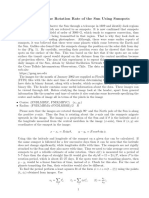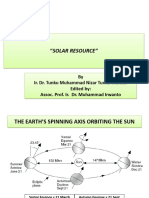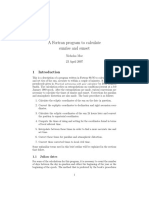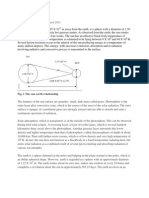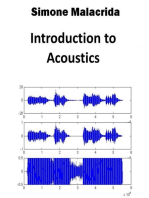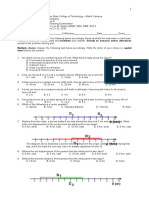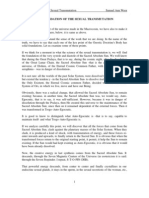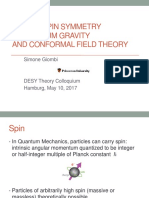Solar Angle and Shortwave Radiation at The Earth's Surface: Environmental Engineering CE 371
Solar Angle and Shortwave Radiation at The Earth's Surface: Environmental Engineering CE 371
Uploaded by
Bhuwanesh KumarCopyright:
Available Formats
Solar Angle and Shortwave Radiation at The Earth's Surface: Environmental Engineering CE 371
Solar Angle and Shortwave Radiation at The Earth's Surface: Environmental Engineering CE 371
Uploaded by
Bhuwanesh KumarOriginal Title
Copyright
Available Formats
Share this document
Did you find this document useful?
Is this content inappropriate?
Copyright:
Available Formats
Solar Angle and Shortwave Radiation at The Earth's Surface: Environmental Engineering CE 371
Solar Angle and Shortwave Radiation at The Earth's Surface: Environmental Engineering CE 371
Uploaded by
Bhuwanesh KumarCopyright:
Available Formats
-1-
Environmental Engineering CE 371
Solar Angle and Shortwave Radiation at the Earths Surface
Shortwave radiation (visible light) is highly directional, so the relative angle of the source and the
receiving surface has a strong effect on the density of the energy flux reaching the surface. (In
contrast, longwave infrared radiation is very diffuse and the exact direction of the source is
relatively unimportant and can usually be neglected.) Thus, to calculate the input of solar heat
from shortwave radiation to a surface we must know the angle between the sun and the surface.
Solar Angle: The solar angle () is the enclosed angle between the sun and the surface of the
earth. This is important because the total insolation received at the surface (I
s
) is reduced from the
perpendicular maximum amount (I
o
) by the relationship I
s
= I
o
sin . At dawn and dusk the solar
angle = 0 by definition, so naturally the insolation drops to zero at those times. Keep in mind
the obvious fact (sometimes forgotten by novices) that the solar angle remains at = 0 all night
(there is no such thing as negative shortwave insolation, which is what a negative would give
you. Keep in mind though that the heat budget sign convention means that the input of positive
shortwave insolation always results in a negative (in) value for heating due to shortwave light,
s
.)
From trigonometric and planetary considerations, the solar angle depends on three variables:
= declination (the seasonally varying angle of the plane traversed by the sun across the sky)
= latitude (the geographic angle along the surface of the earth)
= hour angle of the sun (the angle of the sun along the arc traversed by the sun across the sky)
The formula for solar angle is:
sin = sin sin + cos cos cos
Latitude is easily determined from a map and is constant for a given location. Declination depends on
the day of the year and is obtained from a table of astronomical data known as an ephemeris. A copy of
an ephemeris with declination data is given at the end of this file. You can also follow the link to
NASAs online ephemeris at: http://ssd.jpl.nasa.gov/cgi-bin/eph. Hour angle varies throughout the day
-2-
and is a bit more complicated. However, with a few calculations we can make some useful
simplifications to get average values for an entire day.
Hour Angle: The hour angle of the sun, , is defined such that = 0 at the local solar noon. (I.e.,
when the sun is at its maximum solar angle for the day, or equivalently, when the sun crosses the local
meridian of longitude). In the morning (AM) < 0 (hour angle is negative) and in the afternoon (PM)
> 0 (hour angle is positive).
Maximum Hour Angle,
max
: The total range of possible hour angles on a given date depends on the
local latitude () and on the season of the year, i.e., the earths declination () on that date. Lets call the
maximum possible hour angle for a given date
max
. At the spring and autumn equinoxes, day and night
are exactly the same length (slightly less than 12:00 h) and
max
= 90 . In the winter, the day is shorter
than the night so
max
< 90 and in the summer
max
> 90 . For example, the drawing above shows the
range of hour angles for summertime when the sun rises north of due east and sets north of due west,
resulting in a day length greater than 12 h and
max
> 90 .
How can we calculate
max
for a given date and latitude? We know that the solar angle is calculated
from sin = sin sin + cos cos cos . At dawn and dusk the solar angle is = 0 . And, by
definition, =
max
at dawn and dusk. So, set = 0 = sin and solve for
max
.
0 = sin sin + cos cos cos
max
max
= cos
-1
[(-sin sin )/(cos cos )]
We can convert hour angles to time in hours if we know the time it takes for the sun to traverse one
degree of arc. This is easy to calculate if you recognize that, at the equinox, the sun traverses 180 of
arc in 12.0 h or 720 min. The sun thus takes 4.0 min to move 1 or 40 min to move 10 . Note that we
can also now compute the total day length (excluding any shade from hills, trees, or structures) from
max
:
Day length in min = 2(
max
)(4.0 min/ )
-3-
Example: Calculate the total number of hours of daylight on June 1
st
in Portland, assuming Portland is
at latitude = 45 N.
From the ephemeris we find = 22 on June 1
st
(21 57' to be precise) so:
max
= cos
-1
[(-sin 22 sin 45 )/(cos 22 cos 45 )] = cos
-1
[-(0.37)(0.71)/(0.93)(0.71)] = 114
Total day length = 2(114 )(4.0 min/deg) = 911 min = 15.2 h
This seems reasonable for a long summer day in early June (and with a night period of less than 9 h).
Calculating Average Shortwave Insolation Over an Entire (24 h) Day: For most heat budget
problems we dont want the instantaneous (constantly varying) shortwave flux. Instead we usually need
the daily average heat input from solar shortwave energy. Since I
s
varies as a trigonometric function
over the course of the daylight period, we can calculate the mean insolation for the day from taking the
integral average of solar angle and then multiplying by the fraction of the 24-h day in which the sun is
shining. An alternative and equivalent approach is to integrate the trigonometric insolation function
over the entire day to get total daily shortwave energy input per unit area, which we then divide by the
length of one day to get the mean power flux. We can do all of this using the equations developed
above.
( )
[ ]
s s o o
I I I = = = + sin sin sin (cos cos ) cos
For a given day and location and are constants so we can rewrite the equation as
( )
I I A B
s o
= + cos
To use the mean-value approach, find the average value of the function from sunrise to noon ( = -
max
to
= 0, using units of radians for the hour angle)
{ }
I I A B d
I
A B s
o
o
=
1
2 1 2 1
1
2
1
2
1
2
cos ( ) (sin )
{ }
I
I
A B s
o
=
+
2 1
2 1 2 1
( ) (sin sin )
Example: For June 1
st
, = 22 and a latitude of 45 we found above that
max
= 114 2.0 radians so
from dawn to noon integrate from -2.0 to 0.0 radians. The mean shortwave insolation is then:
{ }
I
I
rad s
o
=
+
+ +
0 2 0
037 071 0 2 0 093 071 0 2 0
.
[( . )( . )]( . ) [( . )( . )][(sin( ) sin( . )]
{ }
I I I s
o o
= + + = 026 033 0 0 91 056 . ( . )[( ) . ] .
So if the maximum solar insolation is 1000 W/m
2
then the surface receives -560 W/m
2
during daylight
hours (only). Therefore over a 24 h day the average insolation input of heat is:
( )
I W m
h
h
W m s
daily
=
|
\
|
.
|
= 560
152
24
355
2 2
/
.
/
Calculating Periods of Sun and Shade: If we are interested in the number of hours per day an object
is in sun or shade, we need to know the value of at which shade begins and ends. We can then project
the time period of sun on either side of local solar noon.
-4-
For example, suppose an object is in shade in
the AM until the solar angle reaches -50 .
The sunlight thus begins (50 ) x (4 min/ ) =
200 min = 3:20 h before local solar noon or
at 8:40 AM, local solar time. If the shade
resumes at = +50 , then the object is in the
sun until 3:20 PM and the total period of
sunlight is 6:40 h.
Obviously the example given above is for a simple and symmetrical geometry of objects with
respect to the sun, and where we know the times of sun and shade with respect to the hour angle. If
we know the clock times of sun and shade, we would have to work backwards to get the hour angles
that correspond to those times.
To compute the daily average shortwave insolation for a shaded water body, simply repeat the
integration method shown above, but instead of starting at dawn, start the averaging integral at the
hour angle when direct light hits the stream and end at noon as before. This approach works fine for
a relatively narrow stream where we can assume all of the stream is in either sun or in shade. For a
wide river or a lake, there is a gradual transition from shade to sun and we would need to include a
second integral to average the area of water under sunlight as the shade retreats across the surface in
the morning and returns in the afternoon. We will not worry about that here..
You might also like
- Midheaven Extension ProcessDocument11 pagesMidheaven Extension ProcessSharon Wilson86% (7)
- Solar Radiation GeometryDocument11 pagesSolar Radiation GeometryRaghu Chowdary90% (10)
- CIV300Document10 pagesCIV300Numal JayawardenaNo ratings yet
- Non-Conventional Energy Sources NotesDocument22 pagesNon-Conventional Energy Sources Notes3vedi100% (10)
- Lecture ThreeDocument21 pagesLecture ThreeAhmed KadhimNo ratings yet
- Solar Energy & Its Measurement: Chapter - 1Document35 pagesSolar Energy & Its Measurement: Chapter - 1Vinay MaisuriyaNo ratings yet
- Lecture 3.1 - Solar Properties (Part 1)Document30 pagesLecture 3.1 - Solar Properties (Part 1)Dum AccountNo ratings yet
- Solar Radiation CalculationDocument49 pagesSolar Radiation CalculationOrlando DunstNo ratings yet
- Practice Problem Set 1: Exploring The Geometry of Terrestrial EnergyDocument14 pagesPractice Problem Set 1: Exploring The Geometry of Terrestrial EnergyKhodr ChehadeNo ratings yet
- Lec 31Document4 pagesLec 31ENGINEERING EXTRACTSNo ratings yet
- Properties of Sunlight - Part IDocument46 pagesProperties of Sunlight - Part ISonu Singh ThakurNo ratings yet
- Istage1 en Length of Day GuideDocument3 pagesIstage1 en Length of Day Guide陈爱军No ratings yet
- Chapter 5 - PV Systems - April 11 - 2011 PDFDocument586 pagesChapter 5 - PV Systems - April 11 - 2011 PDFEl Shaarawy100% (1)
- Solar intensity calculation: Latitude φDocument9 pagesSolar intensity calculation: Latitude φمحمدعبداللهNo ratings yet
- Solar Radiation GeometryDocument62 pagesSolar Radiation GeometrySai ReddyNo ratings yet
- Notes - Second Mid Term PDFDocument87 pagesNotes - Second Mid Term PDFguluNo ratings yet
- Lec 32Document5 pagesLec 32Drake BellNo ratings yet
- 2011 - 12 Example ADocument18 pages2011 - 12 Example Askywalker_handsomeNo ratings yet
- UntitledDocument26 pagesUntitledsahitNo ratings yet
- REnT 05Document61 pagesREnT 05Anime WonderNo ratings yet
- Mathematical Association Is Collaborating With JSTOR To Digitize, Preserve and Extend Access To The Mathematical GazetteDocument5 pagesMathematical Association Is Collaborating With JSTOR To Digitize, Preserve and Extend Access To The Mathematical GazetteAnirudha BarmanNo ratings yet
- Teach Slides03Document114 pagesTeach Slides03superbs1001No ratings yet
- Chapter-2 RERDocument20 pagesChapter-2 RERMahmoud TarekNo ratings yet
- Solar Radiation Geometry: Between A Line Drawn From A PointDocument11 pagesSolar Radiation Geometry: Between A Line Drawn From A PointN.manoj reddyNo ratings yet
- Solar Energy FundamentalsDocument32 pagesSolar Energy Fundamentalspiranna7400No ratings yet
- The SunDocument26 pagesThe SunleahNo ratings yet
- Solar Calculations: © 2007, K. E. HolbertDocument7 pagesSolar Calculations: © 2007, K. E. HolbertJohn A. DíazNo ratings yet
- Examples of ProbsDocument8 pagesExamples of ProbsSantosh G PattanadNo ratings yet
- Solar Radiation: Lecture NotesDocument7 pagesSolar Radiation: Lecture NotesPHjecrisNo ratings yet
- 11-Prof - Ishraque Ahmad NCESDocument24 pages11-Prof - Ishraque Ahmad NCES592000hivaNo ratings yet
- 22ee502 - Conventional and Renewable Energy Systems - Unit 3Document58 pages22ee502 - Conventional and Renewable Energy Systems - Unit 3BHUVANA S UEE22012No ratings yet
- Week 3Document23 pagesWeek 3Abdalrahman YahyaNo ratings yet
- Solar AngelDocument13 pagesSolar Angelaoauaz2000No ratings yet
- ERU-1-Part 2Document18 pagesERU-1-Part 2Ahmad AnsariNo ratings yet
- Solar Energy BasicsDocument14 pagesSolar Energy BasicsSuprava GhoshPaulNo ratings yet
- Lecture Slides - Solar Energy Basics and UtilizationDocument103 pagesLecture Slides - Solar Energy Basics and UtilizationDebadutta SwainNo ratings yet
- Lecture - 3 SolarDocument87 pagesLecture - 3 Solarjeygar12No ratings yet
- Solar IrradianceDocument8 pagesSolar IrradianceDilasha AdhikariNo ratings yet
- Solar Radiation GeometryDocument11 pagesSolar Radiation Geometry1234efootballNo ratings yet
- SunspotDocument3 pagesSunspotRajat AryaNo ratings yet
- By Engr. Sami Alalwani For RawaqDocument20 pagesBy Engr. Sami Alalwani For RawaqSIDI ahmedou yahyaNo ratings yet
- Solution 10Document10 pagesSolution 10Narendra KumarNo ratings yet
- Calculation of SunriseDocument8 pagesCalculation of SunriseopparasharNo ratings yet
- MPE 571 Chapter 2Document18 pagesMPE 571 Chapter 2Wilbon KibetNo ratings yet
- Lowrie SolutionDocument19 pagesLowrie SolutionVijay Yadav100% (1)
- Heat Evaporate Photosynthesis Reflected Scattered Reflected AbsorbedDocument59 pagesHeat Evaporate Photosynthesis Reflected Scattered Reflected AbsorbedD7myNo ratings yet
- 02-Solar ResourcesDocument41 pages02-Solar ResourcesEdo PrasetyoNo ratings yet
- Solar Radiation: Fig. 1 The Sun Earth RelationshipDocument10 pagesSolar Radiation: Fig. 1 The Sun Earth Relationshipsmg26thmayNo ratings yet
- Solutions For The BOAA Competition Paper April 2015 Revised PDFDocument4 pagesSolutions For The BOAA Competition Paper April 2015 Revised PDFAvik DasNo ratings yet
- Solar Energy FundamentalsDocument25 pagesSolar Energy FundamentalsAvinesh ChandNo ratings yet
- Phea Puthchanrithy - Lighting AssignmentDocument6 pagesPhea Puthchanrithy - Lighting AssignmentRithy PuthchanNo ratings yet
- Rise SetDocument6 pagesRise SetNguyễn ThaoNo ratings yet
- Islamic Praying Time Calculation PDFDocument8 pagesIslamic Praying Time Calculation PDFAnonymous 8bDAHYT6TNo ratings yet
- Pyranometer and PyrheliometerDocument10 pagesPyranometer and PyrheliometerHari PrasadNo ratings yet
- Where did That Number Come From?: Chronological Histories and Derivations of Numbers Important in ScienceFrom EverandWhere did That Number Come From?: Chronological Histories and Derivations of Numbers Important in ScienceNo ratings yet
- Navigation & Voyage Planning Companions: Navigation, Nautical Calculation & Passage Planning CompanionsFrom EverandNavigation & Voyage Planning Companions: Navigation, Nautical Calculation & Passage Planning CompanionsNo ratings yet
- Intensity of Electromagnetic Waves as a Function of Frequency, Source Distance and Aperture AngleFrom EverandIntensity of Electromagnetic Waves as a Function of Frequency, Source Distance and Aperture AngleNo ratings yet
- SPA6311 Physical Cosmology Lecture 1: Introduction and A Map of The UniverseDocument18 pagesSPA6311 Physical Cosmology Lecture 1: Introduction and A Map of The UniverseRoy VeseyNo ratings yet
- Midterm Exam Science 9Document3 pagesMidterm Exam Science 9Leo SindolNo ratings yet
- The Foundation of The Sexual TransmutationDocument7 pagesThe Foundation of The Sexual Transmutationdragosbalaniuc100% (1)
- Positional Astronomy BR Annual ParallaxDocument4 pagesPositional Astronomy BR Annual ParallaxgarryhodgesonNo ratings yet
- The Pumping LemmaDocument40 pagesThe Pumping LemmaM Ayzed MirzaNo ratings yet
- L6 Mock TestDocument16 pagesL6 Mock TestCarolina GómezNo ratings yet
- Appel Maths For Physicists PDFDocument666 pagesAppel Maths For Physicists PDFEdgar Martínez100% (1)
- Tesla and The A EtherDocument4 pagesTesla and The A EtherMilan Petrik100% (2)
- Statistical Thermodynamics IIDocument9 pagesStatistical Thermodynamics IIPinoteDiegoNo ratings yet
- Physics SignatureDocument6 pagesPhysics Signatureapi-298076813No ratings yet
- Negative Yogas in Your Birth Chart and Their RemediesDocument2 pagesNegative Yogas in Your Birth Chart and Their Remediessurinder sangarNo ratings yet
- 2nd Letter To Project CamelotDocument2 pages2nd Letter To Project CamelotRandy GeorgeNo ratings yet
- Gravity: by Benjamin Gal-Or, All Rights ReservedDocument17 pagesGravity: by Benjamin Gal-Or, All Rights ReservedProf.-Dr. Benjamin Gal-OrNo ratings yet
- Bangalore Press Calendar 2023Document12 pagesBangalore Press Calendar 2023ankappatd0% (1)
- Zizek On Heidegger and Other ThingsDocument20 pagesZizek On Heidegger and Other ThingsThomas RubleNo ratings yet
- Kevin Juandi. Project 066Document16 pagesKevin Juandi. Project 066趙子賢No ratings yet
- Higher-Spin Symmetry in Quantum Gravity and Conformal Field TheoryDocument51 pagesHigher-Spin Symmetry in Quantum Gravity and Conformal Field TheoryKamilNo ratings yet
- What Is An AsteroidDocument4 pagesWhat Is An Asteroidapi-302899266No ratings yet
- Force QuestionsDocument19 pagesForce QuestionsMohammadTalal277No ratings yet
- Archaeoastronomy at Bhubaneswar A PolygoDocument22 pagesArchaeoastronomy at Bhubaneswar A Polygovijaydhakre2002No ratings yet
- IrurayDocument2 pagesIrurayJenn OamilNo ratings yet
- Alien EncyclopediaDocument12 pagesAlien Encyclopediadobermannmx100% (2)
- Zodiac Signs BoardDocument15 pagesZodiac Signs BoardMasaō AshtineNo ratings yet
- Intellectual Revolution PDFDocument42 pagesIntellectual Revolution PDFEris OhNo ratings yet
- Update of Global Two-Higgs-Doublet Model Fits: Debtosh - Chowdhury@polytechnique - Edu Otto - Eberhardt@ific - Uv.esDocument40 pagesUpdate of Global Two-Higgs-Doublet Model Fits: Debtosh - Chowdhury@polytechnique - Edu Otto - Eberhardt@ific - Uv.espippoaNo ratings yet
- Cj53 Public PartDocument5 pagesCj53 Public PartbarryhopewellNo ratings yet
- Astrological Combinations For Career in IAS - Life+Document8 pagesAstrological Combinations For Career in IAS - Life+Tamal Kanti MoulikNo ratings yet
- PHYS 624 (Fall 2010) : Advanced Quantum Mechanics Homeworks 1 Homework 1 (Classical Field Theory), Due Wednes-Day, September 15Document24 pagesPHYS 624 (Fall 2010) : Advanced Quantum Mechanics Homeworks 1 Homework 1 (Classical Field Theory), Due Wednes-Day, September 15Stephen RandallNo ratings yet
- RotnDocument23 pagesRotnDeepanshu LullaNo ratings yet







































